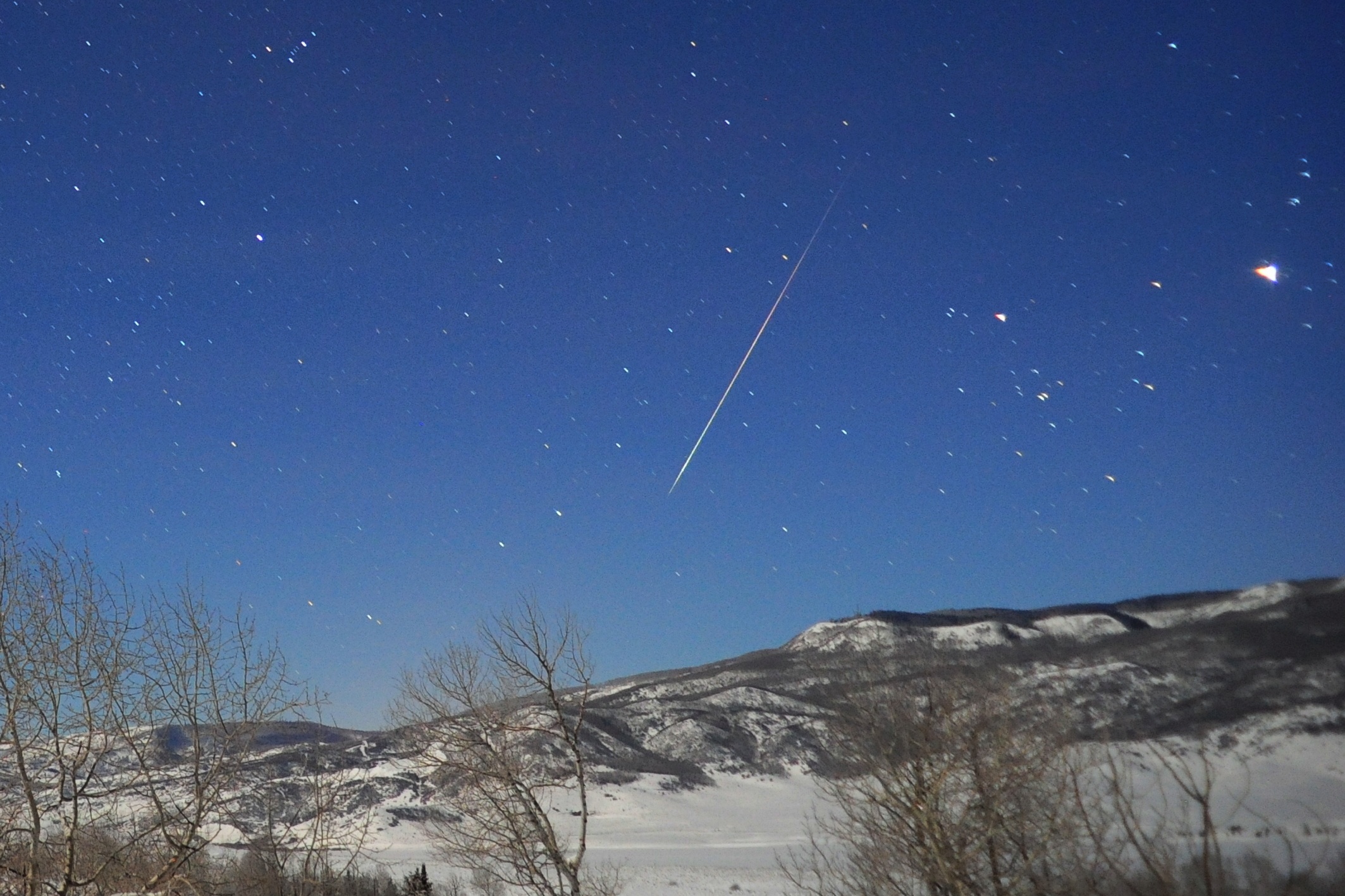
Anyone gazing at the summer night sky for even a short time is likely to spot a few "shooting stars" darting across the sky.
The best and most beloved meteor display of the summer comes during the second week of August: the annual Perseid shower which, at its peak around the nights of Aug. 11 and 12, is capable of producing anywhere from 50 to 100 fast, bright meteors per hour.
Sadly, this year will be a poor one to watch for the Perseids, chiefly because an almost full moon will greatly interfere with observations. But there are plenty more to watch for. In general, Earth encounters richer meteoric activity during the second half of the year. And you're more likely to see twice as many meteors per hour before dawn than in the evening. This is because we are on the "trailing" side of Earth during the pre-midnight hours, thanks to our orbital motion through space. So any meteoric particle must have an orbital velocity greater than that of the Earth to "catch" us.
Related: Perseid Meteor Shower 2019: When & How to See It
However, after midnight when we are turned onto Earth's "leading" side, any particle that lies along Earth's orbital path will enter our atmosphere as a meteor. As such objects collide with our atmosphere at speeds of 7 to 45 miles per second (11 to 72 kilometers per second); their energy of motion rapidly dissipates in the form of heat, light and ionization, creating short-lived streaks of light popularly referred to as falling stars or shooting stars.
Minor league showers
To go along with the Perseids, however, there are a few other minor meteor displays during July and August. These summertime meteors, occasionally flitting across your line of sight, are especially noticeable between mid-July and the third week of August. While the hourly rates from these other meteor streams are just a fraction of the numbers produced by the Perseids, overall they provide a wide variety of meteor colors, speeds and trajectories. Among these spectacles are:
The Southern Delta Aquarids, which reached their peak around July 28 and can produce faint, medium-speed meteors, with perhaps an average of 10 to 20 per hour streaking from out of the southern part of the sky between midnight and dawn. They are active from July 12 through Aug. 23.
Get the Space.com Newsletter
Breaking space news, the latest updates on rocket launches, skywatching events and more!
The Alpha Capricornids, which arrive at their maximum a couple of nights later on July 30, are described as slow, bright (occasionally fireball-class), long-trailed meteors. Like the Southern Delta Aquarids, they appear to streak from out of the southern sky, but even at their peak they number at best only five per hour. The first forerunners of this meteor stream have been sighted as early as July 3 and the last stragglers as late as Aug. 15.
The peak of both of these displays coincide with a thin waning crescent moon, providing little interference for prospective meteor observers.
The Kappa Cygnids, peaking near Aug. 17, have been classified as "slow moving and sometimes brilliant." Kappa Cygnid hourly rates are very low, only a few per hour. Unfortunately, a bright waning gibbous moon rises during the mid-to-late evening hours to brighten the sky.
But because there is the possibility of getting a glimpse of a superbright meteor, they are still worth a look. The constellation Cygnus, from where these meteors diverge, appears almost directly overhead around midnight. Like the Southern Delta Aquarids and Alpha Capricornids, the Kappa Cygnids are active for at least a few weeks, from Aug. 3 through Aug. 25.
Back in 2008, Peter Jenniskens of the Carl Sagan Center, SETI Institute, announced that he had identified the probable breakup of a comet from several thousand years ago that may be responsible for the Kappa Cygnids; the asteroid 2008 ED69 may be a fragment from that breakup.
Final thoughts
As meager as the individual hourly rates are with these minor displays, collectively they become strikingly augmented with the Perseids, whose numbers will begin revving up during early August. Indeed, August is Perseid month, and the skywatching is boosted by raising sporadic meteor rates, mild weather overnight, other minor meteor showers and vacation time for many.
The waxing moon will not become a significant issue for skywatchers until after Aug. 8. Even though bright moonlight will wreak havoc with the 2019 Perseids, there is still a way to avoid that moon and get some dark skies around the time of their peak activity. We'll advise you on how to accomplish this here at Space.com early next month, so stay tuned!
- How to See the Best Meteor Showers of 2019
- Best Night Sky Events of July 2019 (Stargazing Maps)
- The Brightest Visible Planets in July's Night Sky: How to See them (and When)
Joe Rao serves as an instructor and guest lecturer at New York's Hayden Planetarium. He writes about astronomy for Natural History magazine, the Farmers' Almanac and other publications, and he is also an on-camera meteorologist for Verizon FiOS1 News in New York's lower Hudson Valley. Follow us on Twitter @Spacedotcom and on Facebook.
Join our Space Forums to keep talking space on the latest missions, night sky and more! And if you have a news tip, correction or comment, let us know at: community@space.com.

Joe Rao is Space.com's skywatching columnist, as well as a veteran meteorologist and eclipse chaser who also serves as an instructor and guest lecturer at New York's Hayden Planetarium. He writes about astronomy for Natural History magazine, Sky & Telescope and other publications. Joe is an 8-time Emmy-nominated meteorologist who served the Putnam Valley region of New York for over 21 years. You can find him on Twitter and YouTube tracking lunar and solar eclipses, meteor showers and more. To find out Joe's latest project, visit him on Twitter.









